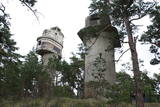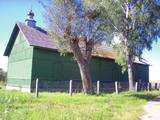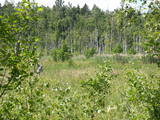| Нo | Название | Описание |
|---|---|---|
|
Эту батарею проще всего найти, идя вдоль берега моря, так как одна из четырех позиций батареи находится на пляже – подмытая морскими волнами. Остальные позиции, телеметрическая вышка и другие элементы расположены недалеко от морского берега – в сосновом лесу. Батарея была построена в сороковых годах прошлого столетия. Отсюда уже видны Северные форты.
|
||
|
Кафе «Павардс» находится в историческом центре Тукумса около площади Свободы. Латышская кухня: Букстиньпутра. |
||
|
Mоленная Кампишкской старообрядческой общины
реконструирована в 1931 году по плану архитектора В. Шервинс-
кого. Храм высокий, просторный и с двумя кельями. В западной
части высокая колокольня, которую украшает крест.
|
||
|
This is the thickest and tallest common ivy in Latvia. It is in the park of the Zentene Estate, opposite the mansion (which is now a school).
|
||
|
Это великолепная возможность вернуться в прошлое – во времена, когда на территории Латвии «господствовал» период узкоколейной железной дороги. Вплоть до 60-х годов прошлого столетия на Северокурземском побережье действовала узкоколейная железная дорога, соединявшая прибрежные рыбацкие поселки. До сего дня сохранились места (еле различимые коридоры на фоне природы), отдельные станционные здания или их остатки. В Вентспилсском Приморском музее под открытым небом можно с интересом проехаться по Круговой линии протяженностью 1,4 км или Горной линии протяженностью 3 км, в конце которой находится поворотный круг. Локомотив узкоколейки был построен в 1916-м году в Германии. Можно также осмотреть станционное здание со всем оборудованием. |
||
|
Viens no labākajiem veidiem, kā iepazīties ar sidru, ir paviesoties kādā no sidra darītavām, kur klātienē var redzēt, kā sidrs tiek gatavots. Vairākas sidra darītavas piedāvā apmeklējumus, kuros sidrdari parādīs ražošanas procesu, ļaus nodegustēt savu produkciju un pastāstīs par to. Sidrdari pieņem apmeklētājus pēc iepriekšējas pieteikšanās. Rezervējiet savu apmeklējumu laikus, lai mazajās saimniecībās, kur bieži vien strādā tikai pati ģimene vai pāris darbinieku, sidrdari var paspēt apvienot tūristu uzņemšanu ar savu ikdienas darbu. Parasti sidra darītavas uzņem viesus visu cauru gadu, dažos gadalaikos ir iespējams vērot arī ražošanas procesu, tādēļ sidra darītavas apmeklējumam ieplānojiet apmēram 2 stundas. |
||
|
The ship "Baltā Kaza" transports tourists along the Daugava and also acts as a ferry from Jaunjelgava to Skriveri. In the summer season it runs at regular times. Excursions and trips to the Love Island, Aizkraukle castle ruins, Ķegums HPP, etc. are also possible. Other routes are possible. 25 passenger seats. During the trips you can get acquainted with the narration of cultural-historical, historical and biological objects on both banks of the Daugava. The owner organizes events and concerts both on the Daugava and on the bank of the Daugava. Possibility to rent SUP boards, rowing and canoe boats, catamarans at the berth. |
||
|
Mūsdienās redzamais parks starp Rīgas un Parādes ielu tapa vairāk nekā pirms 100 gadiem un tā patrons bija pilsētas pirmais mērs - Pāvels Dubrovins (1839. – 1890.). Pilsētas „zaļā saliņa”, kuras centrā atrodas strūklaka, ir iecienīta atpūtas un pastaigu vieta. Atraktīvs ir no bronzas veidotais piemineklis (2007. g., tēlnieks A. Tartinovs),kas veltīts pilsētas pirmajam mēram. |
||
|
Palmse Manor is known to be considered as one of the most beautiful manors in Estonia. The manor has been mentioned first in 1510 as a property of women's monastery. In later centuries it belonged to Palenu family. Manor was built in 1697 but it was made the way we see it nowadays in 18th century. It has been renovated one more time in 1970-1980's. Around the building is a big and scenic park with several ponds. Inside the manor you can become familiar with its interior and visit the basement as well as buy Estonian wine. |
||
|
Этот тур сочетает в себе кулинарные впечатления с посещением популярных туристических достопримечательностей на юге Эстонии. Вы посетите Выру и Рыуге, насладитесь пейзажами южной Эстонии в природном парке Хаанья с вершины Суур Мунамяги, самого высокого холма в Прибалтике, и вас искренне приветствуют в Сетомаа, земле Сетоса - этнического и языкового меньшинства, которое продолжает их уникальные традиции наследия. Сетомаа был заселен около 8 400 лет, что делает его одним из старейших населенных пунктов в Эстонии. В этом туре вы попробуете эстонские вина, приготовленные из местных ягод и фруктов, посетите козью ферму, предлагающую превосходный козий сыр, а в деревенской усадьбе вам предложат сытные деревенские блюда. Маршрут начинается и заканчивается в Тарту, но его можно продлить в / из Таллинна и Риги. |
||
|
В мастерской можно познакомиться с керамической посудой различных этапов истории, изготовлением и применением предметов быта. Познакомиться с археологической керамикой, средневековой глиняной передвижной печью для выпечки хлеба, сковородой, кубками для питья, посудой паломников для воды. Все работы выполнены в технике лепной керамики и обожжены в дровяной печи. |
||
|
This swampy territory used to be part of a Littorena Sea lagoon, and it is a place where many rare and protected birds such as woodpeckers live and nest. Territory is hard to reach although some of the territory can be surveyed from the Tukums-Kolka road. Wet meadows is called "lankas" in Kurzeme region. |
||
|
Скульптор по дереву создает из дерева саржи политиков, работников культуры и популярных людей, которые можно приобрести. Можно заказать декоративные предметы из дерева, сделанные под открытым небом. Художник делает и распятие. Художница в технике масляной живописи пишет натюрморты, мастерски используя свет и игру теней. Продажа работ. |
||
|
The nature trail was built in 2003 supported by the WWF, the Latvian Environment Protection Fund, the International volunteering organization supporting conservation initiatives in the United Kingdom (BTCV) involving volunteers from Nīca and Rucava municipal parishes. The trail exposes the surrounding landscapes and related biotopes – dunes, forest, grasslands and bog, as well as bird and animal species found there. On the trail, there is a bird watching tower and two birdwatcher hides. You can see the rivers Paurupe and Līgupe, beaver activity areas, grasslands, black alder forest, spruce forest, floodland, wild horses, aurochs, the Šķilu lime tree, the Holy Grove, the Ezerskolas sacrificial stone, the Pape ornithological field station, the Papes polder grasslands and the Pape lighthouse. There are resting places en route. The trail leads through the historical Ķoņu village with the traditional coastal fishing village architecture of buildings and yards. The trail is 9 km (5 km one way by a gravel road, returning 4km along the coastline). The trail is in the Pape nature park
|
||
|
Ceļa malā, kas ved uz Kärdla pilsētu, ir zivju pārstrādes veikals, kur iespējams iegādāties Hījumā zvejnieku nozvejotas zivis gan svaigas, gan kūpinātas, kā arī tiek pārdoti Hījumā mazo ražotāju produkti. Zivis iespējams nobaudīt arī turpat uz vietas, veikalā ir kafejnīcas stūrītis, bet vasarā ārpusē ir terase.
|
||
|
Formed on the left side of river Emajõgi, in the valley of Doma Hill. The centre of The Old Town of Tartu is Town Hall Square with Town Hall and the fountain "The Kiss of the Students" (symbol of the city). |
||
|
This territory is rich with forestland and lakes (some 285 in all). There are extensive opportunities for active recreation or calm leisure.
|
||
|
Этот маршрут приглашает вас посетить Курземе и попробовать там традиционные блюда. Тур начинается из Риги и ведет вас по живописным природным местам на прогулку, которая послужит физическим упражнением для повышения аппетита. В ресторане Dieniņas вы насладитесь традиционной копченой рыбой, мастер-классом по выпечке «sklandrausis», традиционным морковным пирогом, посетите рыбацкие деревни в Национальном парке Slītere и отведаете изысканные блюда в городских пабах Вентспилса. Хорошие достопримечательности в пути - это крутое побережье Балтийского моря в Jūrkalne и средневековый город Кулдига. На водяной мельнице 19-го века, которая в настоящее время является органической фермой, хозяйка даст вам мастер-класс по приготовлению региональных блюд из лани, форели, овощей и фруктов. Последняя остановка на пути обратно в Ригу - Музей шоколада в Pūre. |
||
|
Проживая в Алуксне, немецкий пастор Эрнст Глик сделал одну из важнейших работ в своей жизни – перевел Библию на латышский язык. В 1685 году он закончил перевод Нового Завета, а в 1689 году - перевод Ветхого Завета. В память о выполненной работе до сих пор зеленеют два посаженных священником дуба. |
||
|
Iespēja patīkamā atmosfērā baudīt ļoti gardu ēdienu. . Starp tiem arī Lietuviešu tradicionālo ēdienu. Ir dienas un vakara īpašie piedāvājumi. |
||
























